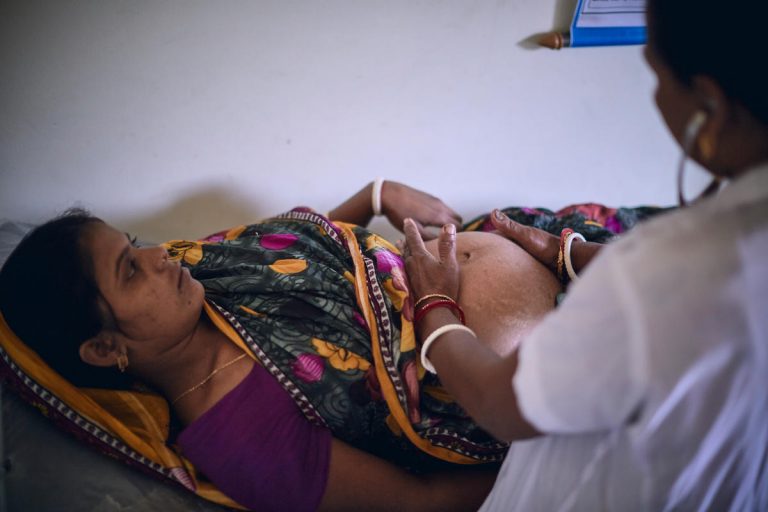This post was originally published as a commentary in The Lancet Global Health here.
An estimated 355 000 adverse pregnancy outcomes occur annually due to syphilis,1 two-thirds of which result in stillbirth or neonatal death.2WHO launched the Elimination of Mother-to-Child Transmission of HIV and Syphilis initiative in 2014.3However, antenatal syphilis screening and treatment rates remain low across sub-Saharan Africa and parts of Asia,4 particularly compared with progress made to reduce new HIV infections among infants, which have declined from 270 000 in 2010 to 180 000 in 2017.5
Reducing the difference between HIV and syphilis antenatal screening rates would lead to major health gains. For instance, in many countries, up to 95% of women are tested for HIV during antenatal care,6but less than 50% are tested for syphilis7(figure; appendix).

Figure: Testing coverage for HIV and syphilis in pregnant women who visit antenatal care in selected countries (2016–18)
This gap represents an opportunity to leverage existing antenatal care platforms and technologies to better diagnose and treat maternal syphilis. In 2015, the first dual HIV and syphilis rapid diagnostic test received WHO prequalification12on the basis of laboratory assessment, with a second test receiving prequalification status in June, 2019.1Field studies show optimal sensitivity (98–100%) and specificity (97–100%) for HIV diagnosis and good sensitivity (89–100%) and specificity (91–100%) for syphilis.14Scale up of dual HIV and syphilis rapid diagnostic tests could close the antenatal care syphilis testing gap, providing an opportunity to deliver treatment with injectable benzathine benzylpenicillin during the same visit. Successful implementation of dual HIV and syphilis rapid diagnostic tests in antenatal care would increase syphilis screening rates to match those of HIV in countries such as India where antenatal care syphilis testing rates would increase by 195%, by 119% in Uganda, and by 117% in Nigeria, without affecting HIV-testing rates.
Policies, guidelines, advocacy tools, implementation plans, screening and diagnostic tests, and effective treatment for syphilis are available.14, 15, 16So why does this HIV and syphilis antenatal care testing gap exist?
In 2018, we delivered a series of maternal syphilis workshops with maternal and child health programmes from 25 African countries to identify reasons for the testing gap and opportunities to increase syphilis screening in pregnancy. We identified poor awareness and political will as contributors to low country application of WHO antenatal care syphilis screening guidelines in the region. In this regard, neither national governments nor donors appear to have identified congenital syphilis prevention as a public health priority and few women knew of the effect of syphilis in pregnancy. Funding for the purchase of syphilis test kits and benzathine penicillin primarily comes from national ministries of health budgets, where prioritisation of syphilis control is low. In addition, donor support is minimal.
Congenital syphilis often falls into the fissures between sexually transmitted infections (STI), maternal and child health, and reproductive health programmes, despite WHO advocacy for service integration as part of universal health coverage.17For example, some HIV programme managers regarded adding syphilis to prevention of mother-to-child transmission (PMTCT) programmes as complicating the process towards elimination of mother to child transmission of HIV.
The level of investment in syphilis diagnosis and treatment is telling when compared with the advocacy, procurement, supply chain, and training systems associated with national HIV programmes. Workshop participants repeatedly described restrictive procurement practices, incomplete demand forecasts, inefficient distribution of syphilis tests, shortages or stockouts of benzathine penicillin, and missed opportunities to leverage health-care worker training.
Integration of maternal syphilis screening and treatment into HIV PMTCT programmes is logical. During the workshops, countries developed national roadmaps for the adoption of new testing algorithms including HIV and syphilis rapid diagnostic tests, forecasting and procurement of test kits, quality assurance, training, and increasing community awareness of syphilis and its association with stillbirth prevention. Subsequently, many countries, with donor and partner support, have commenced activities to identify reliable and predictable sources of additional funding to leverage and supplement existing HIV PMTCT programmes to include dual HIV and syphilis rapid diagnostic tests and ensure benzathine penicillin commodity security.
Countries such as Uganda, Kenya, and Nigeria18reported they have already updated their testing algorithm to include the dual HIV and syphilis rapid diagnostic test as the first test for pregnant women attending antenatal care. Several other countries are following suit and workshop participants from remaining countries have indicated high levels of interest in emulating the process.
Multiplex testing technologies now offer the opportunity to immediately close the syphilis HIV testing gap among pregnant women. Integrating maternal syphilis screening and treatment into HIV PMTCT programmes is a feasible, so-called best buy scenario for global health investments, is less costly, and results in the fewest adverse pregnancy outcomes compared with other testing algorithms.19, 20Dual HIV and syphilis rapid diagnostic tests have shown a high overall diagnostic accuracy for HIV, a high specificity for syphilis diagnosis in antenatal clinic settings and are rated as highly acceptable and feasible.21
Using the antenatal care platform for diagnosis of both maternal HIV and syphilis infections using a single rapid diagnostic test is a simple intervention that could rapidly be brought to scale in high-burden countries. This scenario is a test case for WHO’s people-centred integrated service delivery systems. The incremental cost is small, but the potential gains—prevention of stillbirth, preterm birth, neonatal death, and long-term disability of children—are enormous.
The findings and conclusions in this report are those of the authors and do not necessarily represent the official position of the Centers for Disease Control and Prevention or the World Health Organization. We declare no competing interests.
